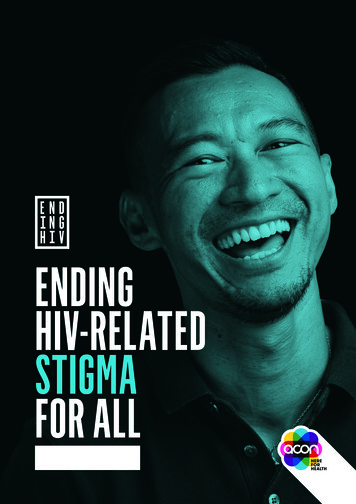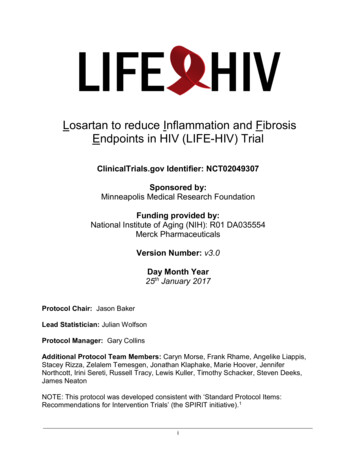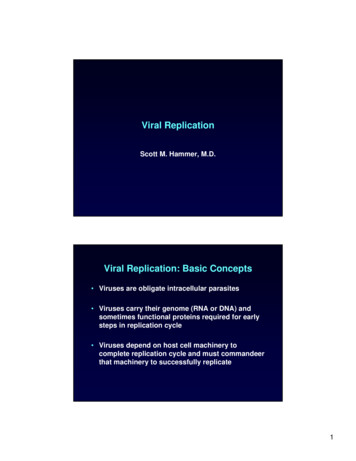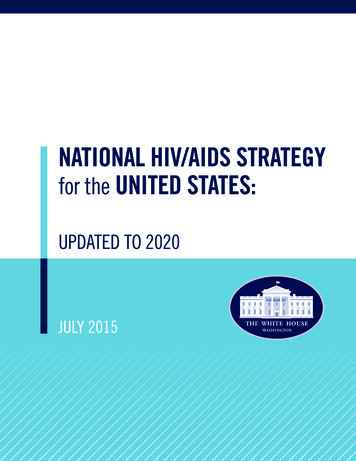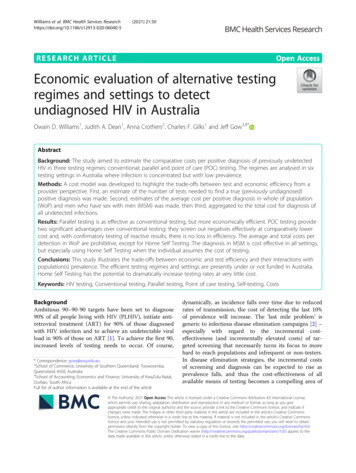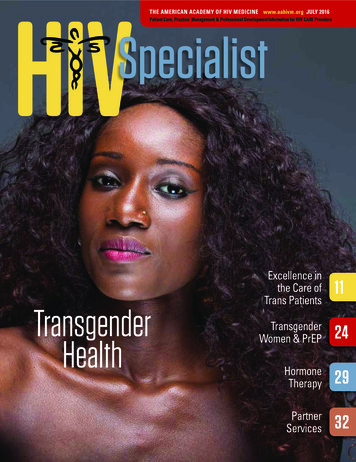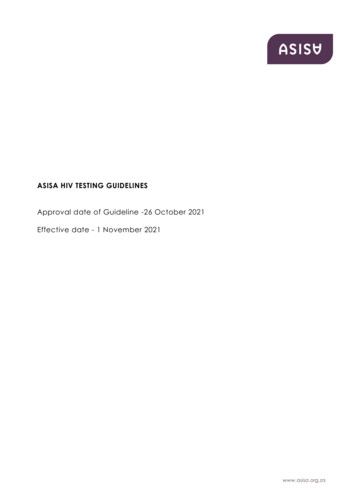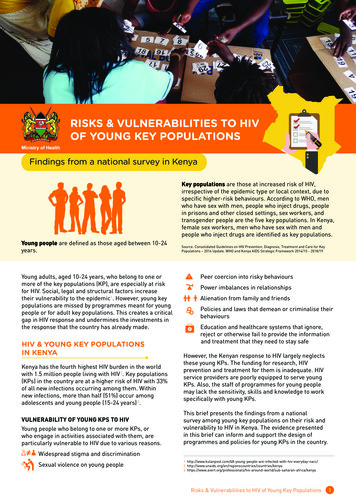
Transcription
RISKS & VULNERABILITIES TO HIVOF YOUNG KEY POPULATIONSFindings from a national survey in KenyaKey populations are those at increased risk of HIV,irrespective of the epidemic type or local context, due tospecific higher-risk behaviours. According to WHO, menwho have sex with men, people who inject drugs, peoplein prisons and other closed settings, sex workers, andtransgender people are the five key populations. In Kenya,female sex workers, men who have sex with men andpeople who inject drugs are identified as key populations.Young people are defined as those aged between 10-24years.Young adults, aged 10-24 years, who belong to one ormore of the key populations (KP), are especially at riskfor HIV. Social, legal and structural factors increasetheir vulnerability to the epidemic1. However, young keypopulations are missed by programmes meant for youngpeople or for adult key populations. This creates a criticalgap in HIV response and undermines the investments inthe response that the country has already made.HIV & YOUNG KEY POPULATIONSIN KENYAKenya has the fourth highest HIV burden in the worldwith 1.5 million people living with HIV 2. Key populations(KPs) in the country are at a higher risk of HIV with 33%of all new infections occurring among them. Withinnew infections, more than half (51%) occur amongadolescents and young people (15-24 years) 3.VULNERABILITY OF YOUNG KPS TO HIVYoung people who belong to one or more KPs, orwho engage in activities associated with them, areparticularly vulnerable to HIV due to various reasons.Source: Consolidated Guidelines on HIV Prevention, Diagnosis, Treatment and Care for KeyPopulations – 2016 Update. WHO and Kenya AIDS Strategic Framework 2014/15 - 2018/19Peer coercion into risky behavioursPower imbalances in relationshipsAlienation from family and friendsPolicies and laws that demean or criminalise theirbehavioursEducation and healthcare systems that ignore,reject or otherwise fail to provide the informationand treatment that they need to stay safeHowever, the Kenyan response to HIV largely neglectsthese young KPs. The funding for research, HIVprevention and treatment for them is inadequate. HIVservice providers are poorly equipped to serve youngKPs. Also, the staff of programmes for young peoplemay lack the sensitivity, skills and knowledge to workspecifically with young KPs.This brief presents the findings from a nationalsurvey among young key populations on their risk andvulnerability to HIV in Kenya. The evidence presentedin this brief can inform and support the design ofprogrammes and policies for young KPs in the country.Widespread stigma and discriminationSexual violence on young people1 ted-with-hiv-everyday-nacc/2 s/kenya3 ld/sub-saharan-africa/kenyaRisks & Vulnerabilities to HIV of Young Key Populations1
METHODAGE AND SEX OF RESPONDENTSPolling Booth Survey (PBS) was used to conduct thisannual outcome survey. PBS participants were recruitedusing a two-stage, stratified cluster sampling procedure.A total of 56 PBS group sessions were conducted overthe duration of the study. Three different questionnaireswere used, for PBS sessions, with young female sexworkers (YFSWs), young men who have sex with men(YMSM), and young people who inject drugs (YPWID).Descriptive analysis produced frequencies, proportions,and comparative statistics. Data were weighted usingKP size estimates and aggregated to provide site-wideestimates for specific indicators, with town and sitetypology breakdowns. All PBS sessions were led by tworesearch assistants, one of whom self-identified as a KPmember.Majority of the young key population respondents werein the age group of 18- 24 years. Less than 10% of theYFSW, YMSM and YPWID respondents were below theage of 18 years. All YFSW respondents were females andall YMSM respondents were males. 36% of the YPWIDrespondents were female.Table 2: Age and sex of respondents by subpopulationFSWsN 280MSMN 242PWIDN 13515 – 17 years1471018 – 24 years250235123Not specified160224299Age range (years)SexMaleFemale28036WHAT DID THE SURVEY FIND?SAMPLE56 total sessions of PBS24with YFSW2111with YMSMwith YPWID657 total respondentsThe sample was drawn from Nairobi andMombasa for all the three subpopulation.Additional site of Kisumu was added for YFSWand YMSM.The National AIDS & STI Control Programme (NASCOP),Kenya, prioritised three study sites - Nairobi, Mombasaand Kisumu - for young key population to account forregional heterogeneity in HIV risk and vulnerability.Table 1: Number of respondents by county Mombasa836561209Kisumu8473-157Total280242135657A. YOUNG FEMALE SEX WORKERSRISK BEHAVIOURSAll YFSW had exchanged sex with other men100% of YFSW had exchanged sex with other men forgood and money in the last one month. A YFSW had anaverage of 19 paying clients per week. 59% of the YFSWalso had regular non paying male partners.YFSW reported engaging in anal sex14% of the YFSW reported engaging in anal sex in thelast one month.Injecting drug use low among YFSWOnly 7% of YFSW reported injecting heroin or othernarcotic drugs in their lifetime. Out of the lifetimeinjectors among YFSW, 65% had injected drugs in thelast one month.Risks & Vulnerabilities to HIV of Young Key Populations2
BEHAVIOURAL OUTCOMESCondom use high with clients and low with regularpartners90% of YFSW used condoms at last sex with a payingclient. In contrast, only 56% of the YFSW used condomsat last sex with a regular non paying male partner.Most YFSW did not receive support during the event ofviolenceOnly 40% of the YFSW reported receiving support from aKP serving organisation during an event of violence.Condom use during anal sex not very highOnly 58% of YFSW reported using condoms during lastanal sex.Reported condom breakage during sex18% of YFSW reported condom breakage and slippageduring sex.Quarter of the YFSW reported not using condomsduring sex25% of the YFSW had at least one occasion ofunprotected sex with a paying client in the last onemonth. Reasons for not using condoms included alcoholconsumption by one of the partners during sex (38%),partners’ unwillingness to wear a condom (33%), andmore money from the client for sex without a condom(27%); and non availability of condoms during sex (26%).Majority of the YFSW had been met by a peer educator87% of FSWs reported meeting with the peer educatorsin the last three months.HEALTH SERVICE OUTCOMESTesting for HIV high among YFSW97% of YFSW reported having tested for HIV in theirlifetime and 84% in the past three months.Less than 70% of YFSW reported ART linkage andadherenceOut of the 18% of YFSW, who reported being HIV positive,only 65% of YFSW were enrolled in ART at the time of thesurvey. 37% of YFSW currently on ART reported missingtheir ART appointment in the last month.Less than a third of YFSW enrolled in PreP29% of the YFSW reported being currently enrolled inPreP, a HIV prevention method.B. YOUNG MEN WHO HAVE SEX WITH MENRISK BEHAVIOURSMajority of YMSM exchanged sex with other men63% of the MSM had exchanged sex with other men intheir lifetime and 61% in the last one month. A YMSMhad an average of 7 clients per week. 80% of the YMSMhad engaged in anal sex in the last one month.YMSM had both male and female partnersMore than half of the YMSM had regular male non payingpartner (63%) and regular female partner (51%).Injecting drug use low among YMSM13% of YMSM also reported injecting heroin or othernarcotic drugs in their lifetime. Out of the lifetimeinjectors among YMSM, 65% had injected drugs in thelast one month.BEHAVIOURAL OUTCOMESMore than 80% of the YMSM used condoms during sex84% of the YMSM used condoms at last sex with a payingclient. A high number of YMSM (85%) reported condomuse at last anal sex.Many YFSW accessed HIV services from the DICA considerable majority (69%) of YFSW reported visitingor receiving services from the drop-in-centres (DIC) orproject clinic in the last 3 months.Condom use with female partners and male partnersvaried for YMSMMore number of YMSM used condoms with a regular nonpaying male partner (82%) as compared to a regular nonpaying female partner (78%).STRUCTURAL OUTCOMESFew reported condom breakageOnly 11% of YMSM reported condom breakage andslippage during sex.Experience of violence from police higher than thatfrom clientsIn the last six months, 47% of the YFSW reportedexperiencing police violence or arrest and 24% forcedintercourse.Less than a quarter reported condom non use16% of the YMSM had unprotected sex with a payingclient on at least one occasion in the last one month.Partners’ unwillingness to wear a condom was the mostcited reason (20%) followed by one of both partnersRisks & Vulnerabilities to HIV of Young Key Populations3
drinking alcohol (17%). About 14% of YMSM reported nonavailability of condoms at the time of sex, and an offer ofmore money from the client for non use of condom, asthe reasons for engaging in unprotected sex.Testing for HIV high among YFSW78% of YMSM had been met by peer educators in the lastthree months.HEALTH SERVICE OUTCOMESTesting for HIV high among YMSM95% of YMSM reported having tested for HIV in theirlifetime and 82% in the past three months.C. YOUNG PEOPLE WHO INJECT DRUGSClose to 80% of YMSM reported ART linkage andadherenceOut of the 20% of YMSM, who reported being HIV positive,77% of the YMSM were enrolled in ART. However, 35%of YMSM reported missing their ART appointment in thelast month.RISK BEHAVIOURSLow PreP enrollment among YMSMAmong YMSM, only 13% reported being currentlyenrolled in PreP.BEHAVIOURAL OUTCOMESMost YMSM accessed HIV services from the DIC75% of the YMSM reported visiting or receiving servicesfrom the drop-in-centres (DIC) or project clinic in the last3 months.STRUCTURAL OUTCOMESLess than 30% YMSM reported violence from police orclientsIn the last six months, 27% of the YMSM reportedexperiencing police violence or arrest and 13% forcedintercourse.Most YMSM did not receive support during the event ofviolenceOnly 41% of the YMSM reported receiving support from aKP serving organisation during an event of violence.Majority (87%) of the YPWID reported injecting heroin ornarcotic drugs in the last one month. A YPWID injected 19times per week.Low condom use and high condom breakage reportedamong YPWIDOnly 63% of PWIDs had used condoms at last sex with apaying client. Use of condoms with a regular non payingpartner was even lower at 45%. Many YPWID (26%)reported breakage of condoms.Clean needle and syringe usage high88% of YPWID had used a clean needle and syringe duringtheir most recent injection. 14% reported sharing needlesat the last injecting episode. 29% of YPWID also reportednon availability of clean needle in the last one month.Most YMSM had been met by a peer educator79% of PWID reported that they had been met by peereducators in the last three months.HEALTH SERVICE OUTCOMESFewer YPWID tested for HIV in the past three monthsWhile 93% of YPWID reported having tested for HIV intheir lifetime, only 73% had tested for HIV in the pastthree months.ART adherence poor among YPWIDOut of the 19% of YPWID, who reported being HIV positive,78% were rerolled in ART at the time of the survey.However, 73% of YPWID reported missing their ARTappointment in the last month.PreP enrollment among YPWID negligibleOnly 3% of YPWID reported being enrolled in PreP.Many YPWID accessed HIV services from the DIC67% of YPWID reported visiting or receiving services fromthe drop-in-centres (DIC) or project clinic in the last 3months.Risks & Vulnerabilities to HIV of Young Key Populations4
STRUCTURAL OUTCOMESMajority of YPWID reported experiencing policeviolenceIn the last six months, 53% of the YPWID reportedexperiencing police violence or arrest. About 20% of theYPWID also reported being subject to forced intercourse.More than half of the YPWID received help to deal withviolence56% of the YPWID reported receiving support from a KPserving organisation during an event of violence.CONCLUSIONThe evidence clearly shows the risks andvulnerabilities of young key populations in Kenya andcalls for an appropriate evidence based programmedesign to address these. Kenya has developed, andrecently launched, the National ImplementationGuidelines for HIV and STI Programming amongYoung Key Populations to provide guidance onprogramming with young key populations to addresstheir risk and vulnerabilities.Written by: Parinita Bhattacharjee and Helgar MusyokiEdited by: Priya PillaiDesigned by: 129 Degrees Design StudioThe research was conducted with support from The Global Fund to Fight AIDS, Tuberculosis and Malaria. The viewsexpressed herein are those of the authors and do not necessarily reflect the official policy or position of GFATM.Risks & Vulnerabilities to HIV of Young Key Populations5
Young adults, aged 10-24 years, who belong to one or more of the key populations (KP), are especially at risk for HIV. Social, legal and structural factors increase their vulnerability to the epidemic1. However, young key populations are missed by programmes meant for young people or for adult key populations. This creates a critical
